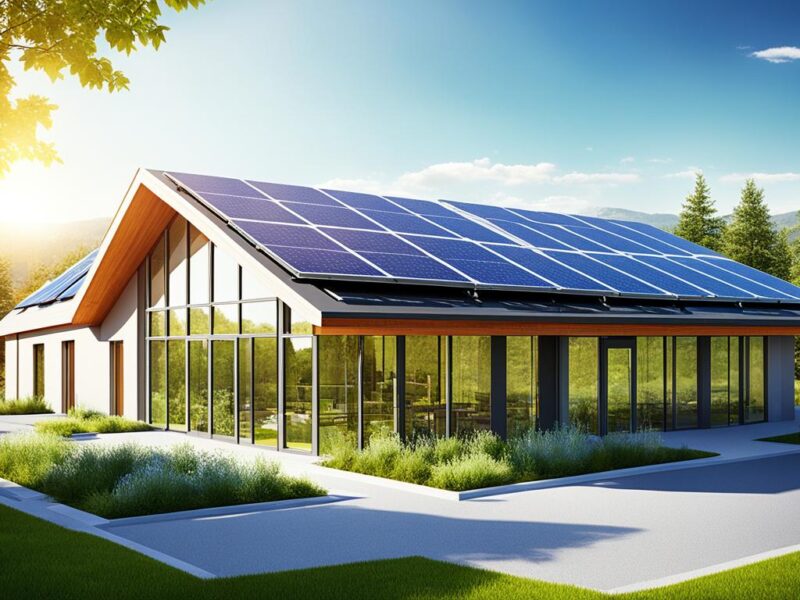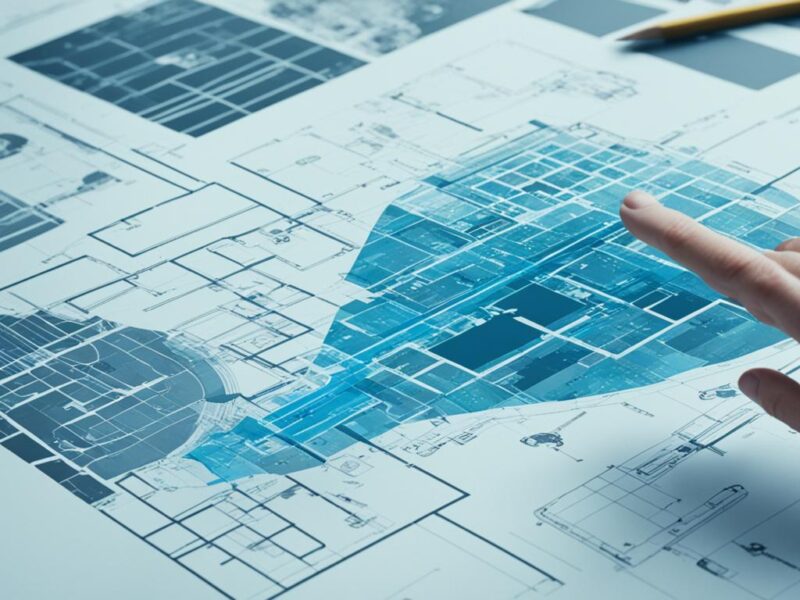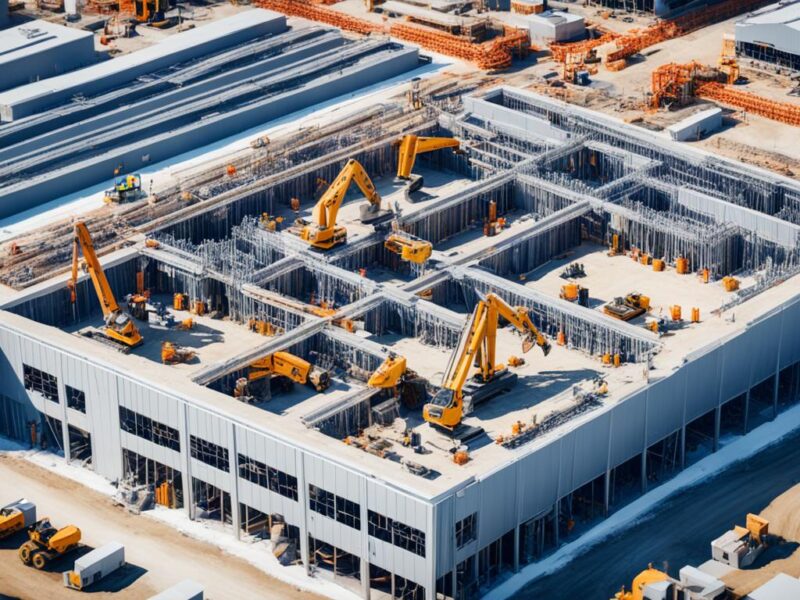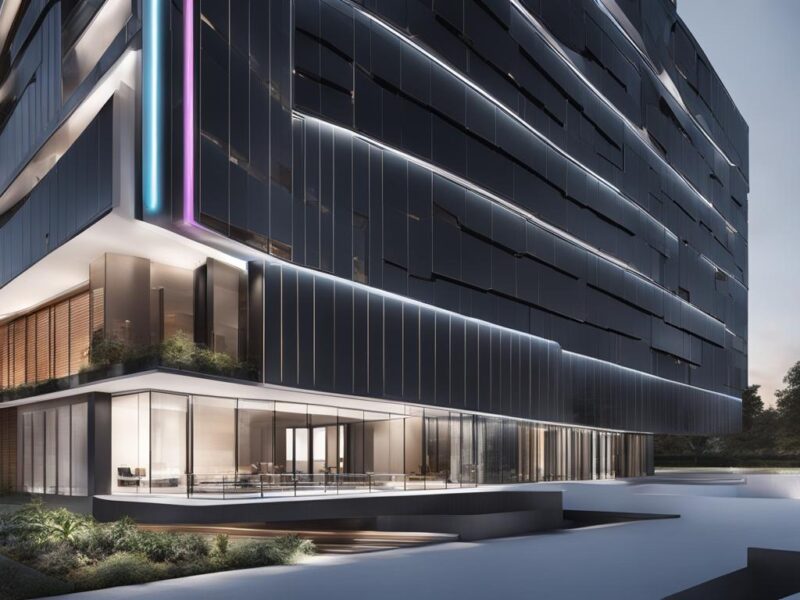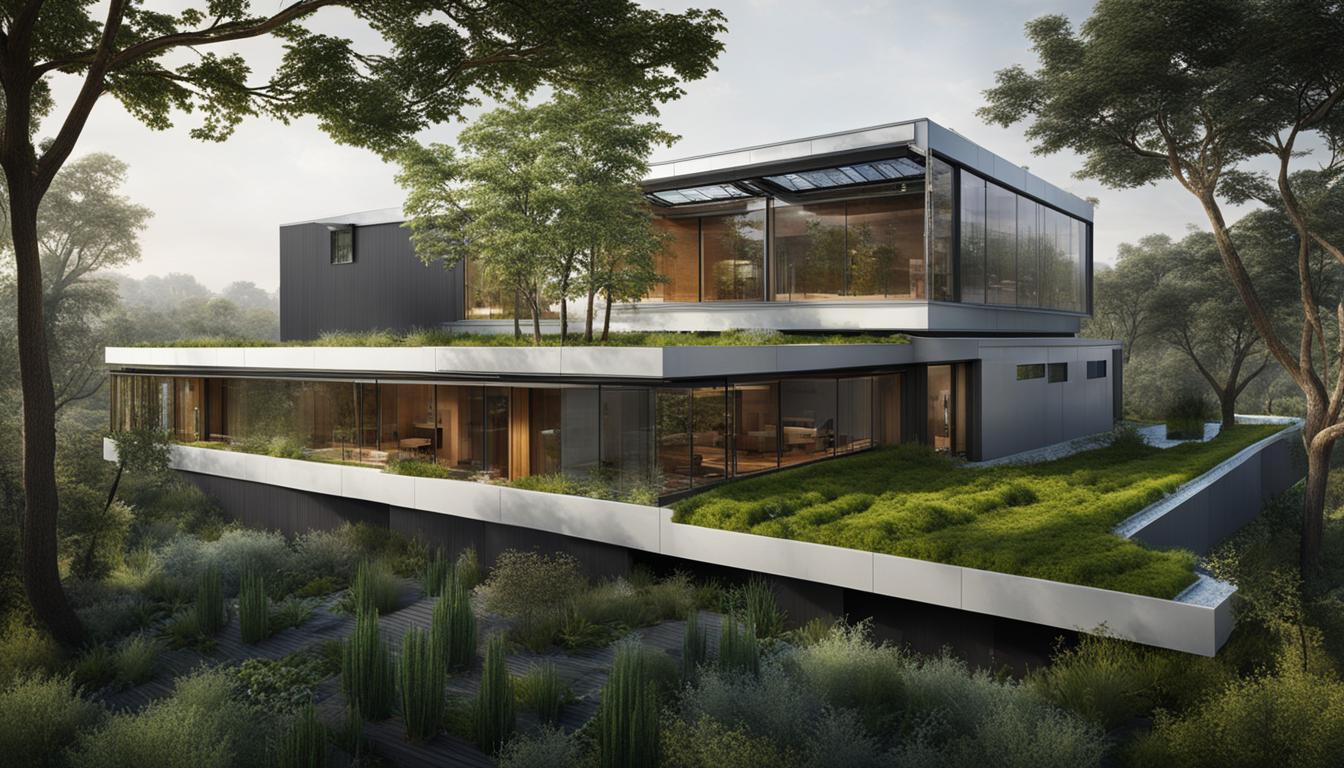
Eco-Friendly Building: Green Construction Techniques
In our quest to foster a more sustainable future, we at Modular Pulse champion eco-friendly construction methods as a pivotal force driving the industry forward. Recognizing the integral role that buildings play within our ecosystem, our dedication lies in endorsing sustainable building practices that harmoniously blend with the environment. We understand that the path toward energy-efficient construction techniques isn’t just beneficial for our planet—it’s essential.
Through our construction technology newsletter, we share insights into the incorporation of green design principles that not only enhance building functionality but also promote wellbeing. It is with pride and commitment that we aid this transformative journey, inviting all to join us in redefining the edifice of future infrastructures. For exclusive updates on these ground-breaking trends, we invite you to subscribe to our platform at https://modularpulse.com/subscribe/.
Key Takeaways
- Eco-friendly construction goes beyond a trend and is rapidly becoming a requirement for a sustainable future.
- Energy-efficient construction is not a stand-alone aspect but a comprehensive approach encompassing materials, design, and execution.
- Green design principles serve as a blueprint for eco-conscious living and building.
- Sustainable building practices contribute significantly to reducing the global ecological footprint.
- Staying informed and involved in green construction innovations is simpler with resources like Modular Pulse.
- Every step towards eco-friendly methods is a stride towards ensuring a healthier environment.
Understanding Sustainable Construction
As pioneers in eco-conscious building, we at Modular Pulse recognize that the future of construction hinges on our ability to adapt. This shift is not merely about new materials and methods—it’s a broader cultural and professional evolution towards sustainable construction technologies and environmentally conscious construction methods. These advancements are transforming the industry and the world we inhabit, promising a more balanced relationship with our environment. Our ongoing mission is to dissect and disseminate the complexities behind this crucial transition through our construction technology newsletter.
The Concept of Sustainable Construction
Envision a construction landscape where low carbon construction practices are the norm, and renewable energy in construction is seamlessly integrated into every project. That vision is the crux of sustainable construction. It’s a concept galvanized by the imperative to use recyclable and renewable resources, meticulously designed to reduce the ecological footprint of buildings. As we integrate these principles into all aspects of construction, we not only construct buildings but also build a resilient future.
Green Construction Materials and Innovation
The advent of materials like insulated access doors and panels signals a significant leap forward in the quest for sustainability. The incorporation of such ingenuities within the construction sector symbolizes a wider acceptance of renewable substances, pioneering a shift towards environmentally friendly practices that align with our eco-conscious ethos. As we explore and advocate for such innovations in our newsletter, we see them as keystones for the industry’s sustainable transformation.
The Role of the Construction Industry in Environmental Impact
In an era where the construction sector is a leading consumer of global resources, its influence on the environment is unparalleled. It’s with a profound sense of responsibility that we acknowledge our industry’s role in addressing global warming—an endeavor that encompasses everything from meticulous resource management to adopting renewable energy in construction. We envision a world where our sector doesn’t just build but sustains, fostering an environmentally conscious construction culture for generations to come.
Core Principles of Eco-Friendly Construction Techniques
At Modular Pulse, we are deeply committed to advancing green construction techniques and ardently believe in the transformative power of sustainable construction methods. By embracing these eco-friendly principles, we can significantly reduce the construction industry’s carbon footprint and contribute to a healthier planet. Let’s delve into the key aspects that constitute the core of sustainable construction.
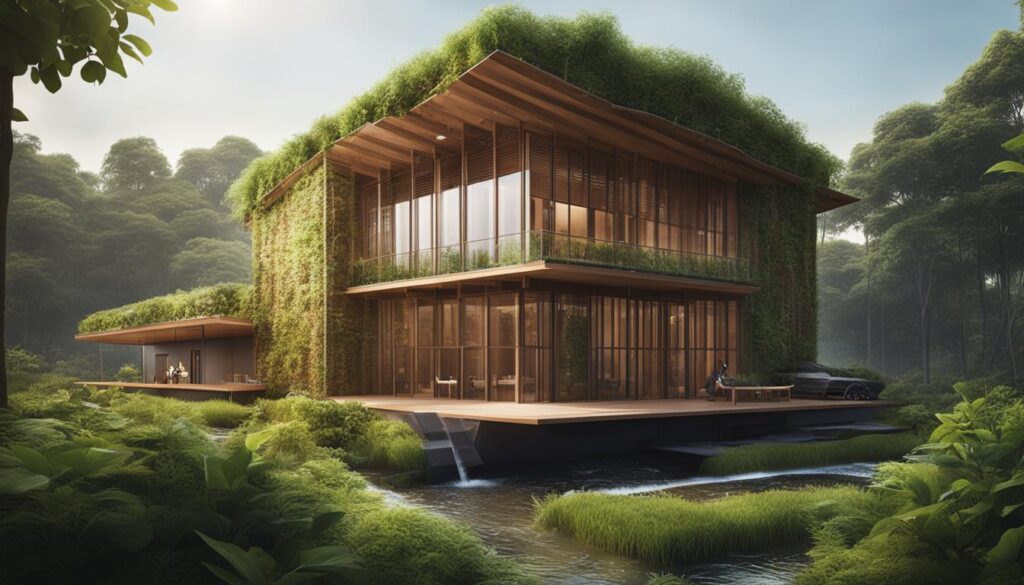
Energy Efficiency in Design and Building
We champion the design and creation of spaces that prioritize energy-efficient construction. Our approach involves meticulous planning to ensure optimal thermal regulation, enhancing performance, and extending the lifespan of buildings while simultaneously conserving vital resources. From smart placement of windows to innovative insulation techniques, our goal is to minimize energy consumption throughout a building’s lifecycle.
Strategic Use of Renewable Resources
Integrating renewable resources is a cornerstone of our construction philosophy. We carefully select materials and technologies that not only serve their purpose effectively but also embody sustainability. Whether it’s harnessing solar energy or utilizing recycled materials, our strategic choices aim to foster resilience and self-sufficiency in the structures we create.
Reducing Waste and Carbon Footprint Through Construction Practices
Mindful of our environmental duties, Modular Pulse employs construction practices designed to reduce waste and carbon emissions. By incorporating recycling protocols on-site and advocating for the use of low-impact materials, we strive to curtail the environmental footprint that accompanies conventional construction. Our dedication to this ethos is evident in every project we undertake, as we work towards a greener tomorrow.
As pioneers in the field, we understand that eco-friendly construction is not just a trend, but a necessary evolution towards sustainable living. We encourage you to learn more about our practices and join our mission by subscribing to our construction technology newsletter at https://modularpulse.com/subscribe/.
Benefits of Green Construction Methods
At Modular Pulse, we’ve watched the eco-friendly construction advantages unfold in real time. These benefits aren’t just a boon for our planet; they enrich our lives and invigorate our economy. With sustainable building benefits, we’re not only crafting spaces—we’re cultivating well-being and fortifying economic resilience.
Delving into the heart of energy savings, these innovative practices cast a wide net of advantages. Sustainable architecture crafts environments that breathe health into every corner, offering a sanctuary that nurtures both mind and body. Moreover, the economic growth in construction linked to sustainability is a testament to the industry’s adaptive dynamism. Our embrace of these methods reflects an unyielding commitment to the kind of growth that uplifts communities and the environment alike.
Here’s a closer look at the tangible positives that eco-friendly construction methods bring to the table:
- Favorable impact on occupant health leading to improved productivity and satisfaction.
- Stimulating job creation through new green technology implementation.
- Long-term financial savings due to reduced operational and maintenance costs.
- Promotion of a sustainable economy by means of responsible construction practices.
We’ve distilled our observations into a construction technology newsletter that serves as a beacon for those navigating the realm of green construction. To capture the essence of these methods, our newsletter is just a click away at Modular Pulse.
| Advantage | Description | Economic Impact |
|---|---|---|
| Healthier Living Environments | Buildings designed with natural light, improved air quality, and non-toxic materials offer better living conditions. | Reduces healthcare costs and increases productivity. |
| Energy Efficiency | Structures make optimal use of resources, significantly cutting down utility bills. | Energy savings translate into financial savings for homeowners and businesses. |
| Material Cost Reduction | Usage of renewable and recycled materials lowers the demand for raw, costly resources. | Decreases overall construction expenses, allowing for budget allocation elsewhere. |
| Carbon Footprint Reduction | Sustainability initiatives lead to a decrease in greenhouse gas emissions. | Contributes to a healthier environment, potentially reducing disaster-related economic losses. |
| Economic Growth | Increased demand for green construction jobs and technologies stimulates the market. | Boosts the national economy through job creation and innovation. |
To grasp the comprehensive scope of sustainable construction’s impact on our world, we invite you to join our vibrant community. Together, let’s explore through the lens of Modular Pulse, where innovation meets sustainability. Engage with us for an enlightened approach to building a future where every structure is a pledge for a greener tomorrow.
Green Building Materials and Technologies
As a leader in promoting eco-friendly building practices, here at Modular Pulse, we’re committed to pioneering the use of green building materials and progressive technologies. Our approach to sustainable development encompasses not only the adoption of cutting-edge environmentally friendly construction products but also the integration of sustainable insulation solutions and the harnessing of renewable energy sources like solar power and geothermal energy. This pursuit of sustainability is reflected in every story we share through our construction technology newsletter.
Exploring the Use of Reclaimed and Sustainable Materials
The paradigm shift toward green construction has ushered in a demand for materials that leave a lighter footprint on the planet. Reclaimed wood, recycled glass, and upcycled content like denim insulation represent the innovative mindset we endorse. By leveraging these green building materials, we close the loop on waste and significantly reduce the need for virgin resources, embodying the principles of a circular economy.
Energy-Saving Appliances and Insulation Techniques
Staying true to our commitment to sustainability, we advocate for energy-saving appliances that bear the ENERGY STAR label, a hallmark of efficiency. By optimizing these appliances together with advanced sustainable insulation solutions, such as those made from recycled newspaper or plant-based products, we can drastically cut energy costs and consumption, laying the foundation for deeply environmentally friendly construction products and practices.
Renewable Energy Systems for Residential and Commercial Buildings
Our vision at Modular Pulse is to see more residential and commercial buildings attain greater energy independence. Incorporating solar power through photovoltaic panels or tapping into the earth’s stable temperature with geothermal energy systems are prime examples of how we can make buildings self-sustaining. These renewable energy solutions embody the essence of green technology, significantly reducing reliance on fossil fuels and bringing us closer to a net-zero carbon footprint.
To discover more about how Modular Pulse is driving the green revolution in building materials and technologies, we welcome you to subscribe to our construction technology newsletter. Visit us at https://modularpulse.com/subscribe/ and become part of the ecosystem of change.
Emerging Trends in Sustainable Construction Techniques
At Modular Pulse, we’ve set our sights on the horizon of advanced sustainable construction, and what we see is a panorama of cutting-edge sustainable techniques evolving at an impressive pace. Encouraged by tax incentives and a unified drive towards sustainability, these techniques are reshaping our industry.
Take zero energy buildings, for example, a clear marker of modern green construction trends. They’re not just buildings; they’re self-sufficient ecosystems, optimized for net-zero energy consumption through meticulous design and eco-innovation in building.
To paint a clearer picture, let’s dive into the specifics that are garnering attention across the nation:
- High-performance insulation materials that drastically slash energy requirements.
- Passive design that leverages natural elements for heating, cooling, and lighting.
- Active solar panels and wind turbines that transform homes and offices into power producers.
Our commitment doesn’t end here. In our construction technology newsletter, we continuously explore the expansive field of eco-friendly development. Let us bring you the latest insights directly through Modular Pulse, where pioneering is our norm.
| Trend | Techniques and Technologies | Benefits |
|---|---|---|
| Zero Energy Buildings | Integration of solar panels, wind turbines, and high-performance insulation. | Achieves net-zero energy consumption, reduces utility costs, and decreases carbon footprints. |
| Passive Design Use | Strategic building placement, window orientation, and thermal mass utilization. | Enhances natural lighting and climate control, minimizes the need for artificial heating and cooling. |
| Solar Power Incentives | Government tax credits and rebates for solar panel installations. | Makes renewable energy more accessible and encourages the adoption of solar technologies. |
In embracing these emerging trends, we are laying down stepping stones for a future where every structure is an embodiment of ecological harmony. Stay abreast of these green construction trends with Modular Pulse—your beacon for sustainable innovation. To be a part of this green revolution, we invite you to subscribe to our newsletter.
Implementing Green Design Principles in Construction
At Modular Pulse, our collective vision for a sustainable future is deeply rooted in the art of implementing green design principles from the inception of any architectural project. Our approach ensures that concepts of sustainable architecture and energy conservation design are embedded in the blueprint of every structure, laying the groundwork for an environmentally conscious and resilient built environment.

Design for Energy Conservation and Sustainability
Emphasizing energy conservation in our designs means that every architectural element, from windows to wall orientations, is chosen to maximize natural light and reduce energy consumption. We are steadfast in our mission to optimize sustainable living environments through intelligent design and the application of energy conservation design techniques.
Incorporating Green Space and Nature into Construction
To us, construction is not only about buildings—it’s about integrating green spaces within our urban landscapes. This interconnectedness with nature is vital for establishing ecological balance and enhancing the well-being of communities. Our designs culminate in spaces where people can connect with the environment while living comfortably within the eco-friendly confines of modern urbanity.
Modular Pulse Insights on Innovative Green Techniques
At Modular Pulse, we are more than just observers of the sustainable construction movement—we are active participants. Our construction technology newsletter offers a treasure trove of sustainable construction insights, spotlighting innovative green techniques that inspire our community of builders, designers, and environmentally-minded individuals. We invite you to join us on this exhilarating journey of discovery and innovation by subscribing at https://modularpulse.com/subscribe/.
Conclusion
As we look ahead, it’s abundantly clear that the pathways we lay today will shape the green construction future. At Modular Pulse, our eco-friendly construction commitment isn’t just a facet of our identity—it’s the bedrock upon which we construct and nurture sustainable living environments. By choosing to embrace sustainable building practices, we’re not only forging a future replete with green innovation but also establishing a living legacy of environmental stewardship.
Our collective efforts in integrating eco-responsible materials, tapping into the vast potential of renewable energy, and employing energy-conservation technologies culminate in benefits that transcend mere aesthetics. These sustainable choices contribute to the well-being of our planet, boost economic vitality, and foster healthy communities. It’s a holistic approach that epitomizes our dedication to the global movement of greening our built environment.
We understand that our journey is shared with countless others, each contributing to the mosaic of a sustainable future. As we at Modular Pulse continue to deliver the latest findings and discussions through our construction technology newsletter, we encourage you to become a part of this pivotal movement. To keep abreast of the progress in green construction and to join the ranks of those leading the charge towards a more eco-conscious world, visit https://modularpulse.com/subscribe/. Together, let’s build a world where every structure is an affirmation of our commitment to the Earth and its future generations.
FAQ
What exactly does sustainable building entail?
Sustainable building involves the adoption of construction practices that are environmentally responsible and resource-efficient throughout a building’s life cycle. This includes the strategic selection of materials, energy conservation, water stewardship, and reducing the overall environmental footprint.
Can you list some eco-friendly construction materials?
Certainly! Eco-friendly construction materials include bamboo, recycled plastic, reclaimed wood, cork, and low-VOC paints. We also see innovations like upcycled denim insulation and bio-glass, which exemplify sustainable material use in the construction industry.
What role does the construction industry play in environmental impact?
The construction industry has a significant impact on the environment due to its heavy consumption of resources and energy, as well as its waste generation. By adopting sustainable construction technologies and methods, the industry can mitigate its environmental impact and lead the way to a more eco-conscious future.
How does energy-efficient construction contribute to building design?
Energy-efficient construction contributes to building design by integrating elements that reduce the need for artificial lighting and temperature control. This can include the use of high-performance insulation, efficient HVAC systems, and orientation that takes advantage of natural light and thermal regulation.
How does the strategic use of renewable resources factor into eco-friendly construction?
Integrating renewable resources, like solar, wind, and geothermal energy, into building designs is essential. Such resources reduce reliance on non-renewable energy, minimize carbon emissions, and in some cases, may lead to buildings that produce as much energy as they consume.
Why is reducing waste and the carbon footprint important in construction?
Reducing waste diverts materials from landfills and cuts down on resource consumption. Minimizing the carbon footprint of construction mitigates the effect of greenhouse gases, which are a major contributor to climate change.
What are the economic benefits of green construction methods?
Green construction methods lead to economic benefits such as reduced operational costs due to energy and water efficiency, increased property values, and job creation through the need for specialized skills and materials that support sustainable construction practices.
How do renewable energy systems integrate with residential and commercial buildings?
Renewable energy systems like solar panels, wind turbines, and geothermal heat pumps can be installed in both residential and commercial buildings to provide clean, low-cost power. New technological advances make it easier than ever to integrate these systems into the energy mix of buildings.
What are some of the emerging trends in sustainable construction techniques?
Emerging trends include net-zero energy buildings, passive solar building design, green roofs and walls, and the use of smart technology to manage building performance. There’s also a growing focus on modular and prefabricated construction that utilizes green materials.
How do green design principles impact construction planning?
Green design principles, when incorporated from the start, guide the entire construction process—ensuring sustainability is a primary objective. This includes the layout to maximize natural light, using environmentally sustainable materials, and integrating systems that reduce energy consumption and water use.
Why is incorporating green space important in urban construction?
Incorporating green space in urban construction provides environmental, psychological, and social benefits. It helps to offset the urban heat island effect, supports local ecosystems, and offers spaces for community recreation and mental respite.
How can I stay updated with the latest in sustainable construction innovations?
You can stay updated with the latest in sustainable construction by subscribing to industry-specific outlets like Modular Pulse, attending webinars and conferences on green building, or even joining professional networks dedicated to sustainable building practices.
Source Links
- https://www.construction21.org/articles/h/the-methods-and-benefits-of-sustainable-construction.html
- https://home.howstuffworks.com/home-improvement/construction/green/10-technologies-used-in-green-construction.htm
- https://www.conserve-energy-future.com/top-15-green-home-building-techniques-and-ideas.php




